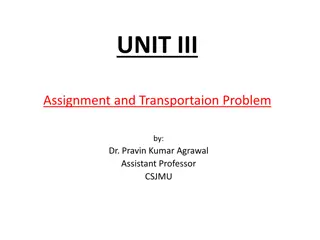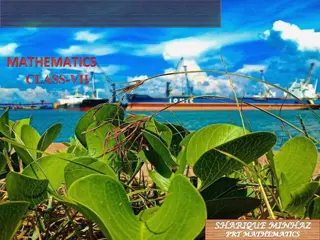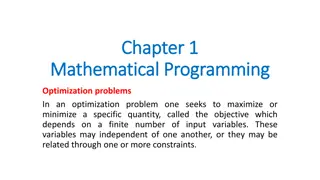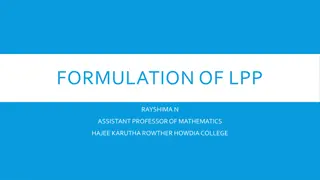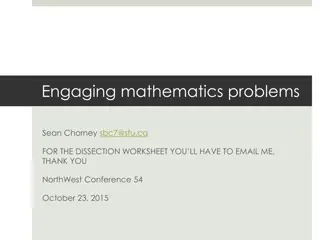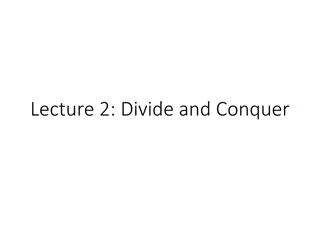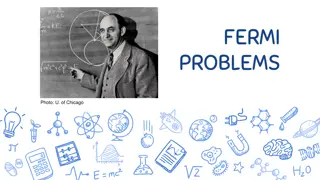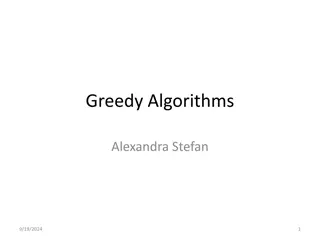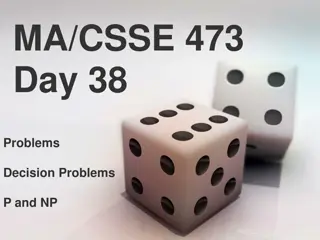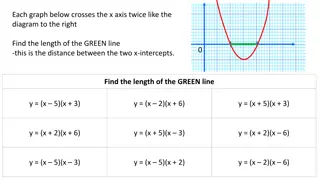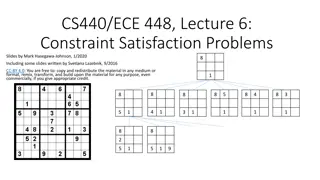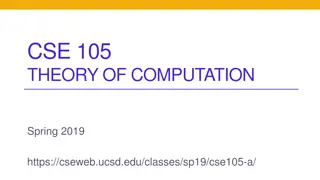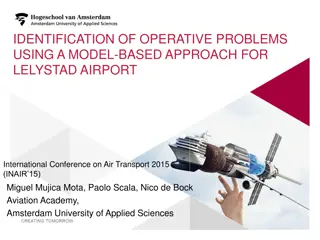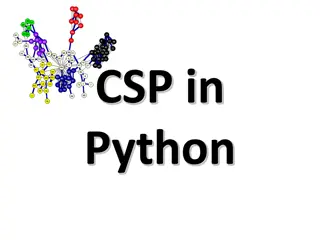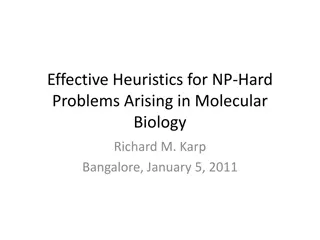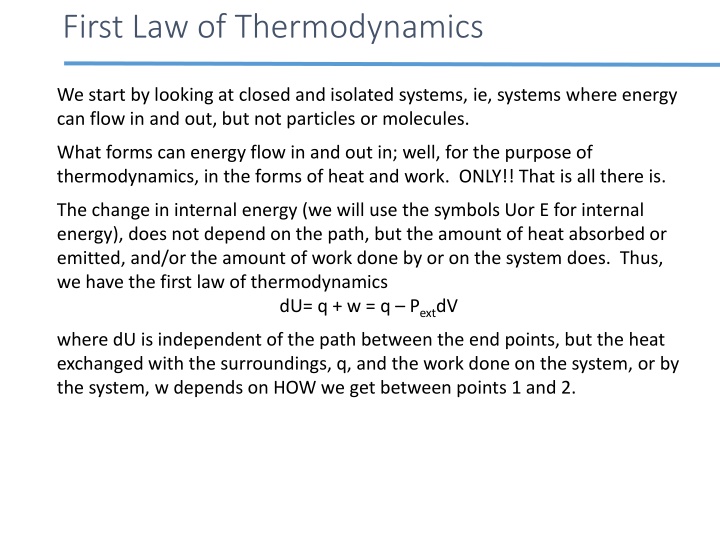
Laws of Thermodynamics
Explore the fundamental laws of thermodynamics, starting with the first law that describes energy flow in closed systems through heat and work. Delve into scenarios involving internal energy changes, work calculations, and enthalpy considerations. Additionally, discover the implications of the second law in terms of heat flow and energy production. Engage with practical examples to grasp the applications of these key principles in thermodynamics.
Download Presentation

Please find below an Image/Link to download the presentation.
The content on the website is provided AS IS for your information and personal use only. It may not be sold, licensed, or shared on other websites without obtaining consent from the author. If you encounter any issues during the download, it is possible that the publisher has removed the file from their server.
You are allowed to download the files provided on this website for personal or commercial use, subject to the condition that they are used lawfully. All files are the property of their respective owners.
The content on the website is provided AS IS for your information and personal use only. It may not be sold, licensed, or shared on other websites without obtaining consent from the author.
E N D
Presentation Transcript
First Law of Thermodynamics We start by looking at closed and isolated systems, ie, systems where energy can flow in and out, but not particles or molecules. What forms can energy flow in and out in; well, for the purpose of thermodynamics, in the forms of heat and work. ONLY!! That is all there is. The change in internal energy (we will use the symbols Uor E for internal energy), does not depend on the path, but the amount of heat absorbed or emitted, and/or the amount of work done by or on the system does. Thus, we have the first law of thermodynamics dU= q + w = q PextdV where dU is independent of the path between the end points, but the heat exchanged with the surroundings, q, and the work done on the system, or by the system, w depends on HOW we get between points 1 and 2.
First Law of Thermodynamics Because energy is conserved Esys = - Esurr and Esys = q+w For pressure volume work E = q - p V When the volume is constant Ev = qv At constant pressure qp = E + p V where p V is the work done ON the system. The enthalpy H = E + PV H= E+ (PV)=q P V + ( P)V + P V = q + ( P)V so at constant pressure H=qp. And for an ideal gas H= E+ (PV)= E+RT n
First Law of Thermodynamics A block of CO2weighing 15 g evaporates in a 5.0 L container at 25 C. How much work has been done if the gas is allowed to expand against an external pressure of 0.98 atm under isothermal conditions? The enthalpy of sublimation of CO2is 25.1 kJ/mol. What is the change in internal energy (kJ/mol) for the sublimation of CO2under these conditions?
First Law of Thermodynamics Acetylene torches, used industrially to cut and weld metals, reach flame temperatures as high as 3000 C. The combustion reaction is as follows: 2C2H2 (g)+5O2 (g) 4CO2 (g)+2H2O(l) H=-2599kJ Calculate the amount of work done against a pressure of 1.0 atm when 4.0 mol of acetylene are allowed to react with 10 mol of O2at 1.0 atm at 20 C. What is the change in internal energy for the reaction?
Second of Thermodyamics Th It is impossible to obtain a process that, operating in cycle, produces no other effect than the subtraction of a positive amount of heat from a reservoir and the production of an equal amount of work. (Kelvin-Planck) q w Tc Th It is impossible to obtain a process that, operating in cycle, produces no other effect than a positive heat flow from a colder body to a hotter one. (Clausius Statement) q Tc
Second of Thermodyamics Th It is impossible to obtain a process that, operating in cycle, produces no other effect than the subtraction of a positive amount of heat from a reservoir and the production of an equal amount of work. (Kelvin-Planck) q w Tc Th It is impossible to obtain a process that, operating in cycle, produces no other effect than a positive heat flow from a colder body to a hotter one. (Clausius Statement) q Tc
Another Way to State Second Law The total entropy of a system and its surroundings always increases for a spontaneous process. Of course to use this we need to know what entropy is
Heat Flow When heat flows from a hot to a cold body the amount of heat flowing into the cold body is positive and the amount flowing out of the hot body is negative q Tcold Since Thot > Tcold then Suniv > 0 q Suniv = Thot Spontaneously heat can flow from a hot to a cold body since Suniv > 0 but not from a colder to a hotter one when Suniv < 0
S Change During Change of State ???? ? ???? ? Sfus= = Calculate the missing data Compound Hfus(kJ/mol) Sfus[J/(mol K)] Melting Point ( C) acetic acid 11.7 16.6 CH3CN 8.2 35.9 CH4 0.94 182.5 CH3OH 18.2 97.7 formic acid 12.7 45.1
Entropy Change At Constant Pressure/Volume The change in entropy when a substance is heated or cooled from temperature T1 to T2 at constant pressure is S = nCp ln ?2 ?1 Where Cp is the molar specific heat at constant pressure and n the number of moles The change in entropy when a substance is heated or cooled from temperature T1 to T2 at constant pressure is S = nCv ln ?2 ?1 Where Cv is the specific heat at constant pressure
Thermodynamic Cycles Changes in the entropy of a system during an irreversible process can be calculated by bringing the system from the initial to the final state by a series of reversible processes
Thermodynamic Cycles Calculate the change in entropy when 36 g of ice melts at 298 K. Cp for water is 4.186 J/g-K and the heat of fusion is 333.55 J/g
Thermodynamic Cycles Calculate the entropy change (J/K) when 4.35 g of liquid bromine are heated from 30.0 C to 50.0 C if the molar heat capacity (Cp) of liquid bromine is 75.1 kJ/(mol K).
Perfect Order and the Third Law At absolute zero where molecules form perfect crystals, there is no disorder and the entropy is zero. This is called Nernst Law after Walter Nernst who first stated it. Nerst s law implies that the entropy of any molecule at any temperature can be calculated by measuring how much heat is added as a function of temperature starting from the perfect crystal at 0 K The Third Law also proves that the entropy of any substance above absolute zero is positive (T is always positive and to warm a substance it has to be heated Nerst also showed that one can never reach absolute zero by a finite number of cooling steps, however, one can get close enough
Standard Molar Entropy The entropy of one mole of a substance at STP is called the standard molar entropy whose symbol is So. The normal units of So are J/mol-K. Standard temperature and pressure are defined by IUPAC as 273.15K (0 oC and 1 bar). Standard applied temperature and pressure is 298 K and 1 atm (SATP). Standard entropies are ABSOLUTE and not relative. In principle they can be found by warming a substance from OK and keeping track of phase changes in addition to the change of entropy in each phase as functions of temperature.
Standard Molar Entropy The entropy of one mole of a substance at STP is called the standard molar entropy whose symbol is So. The normal units of So are J/mol-K. The standard entropy of the elements is a positive number, not zero as is the case for the heat of formation. The standard entropy of a substance is written as So, not So. It is exact.
Change in Entropy for a Reaction The entropy change for a reaction at STP can be calculated in a similar way that the enthalpy change is calculated by Hess law Horeac = n Hof(products)- m Hof(reactants) Soreac = nSo(products)- mSo(reactants)
Change in Entropy for a Reaction Calculate S for each reaction. H2(g) + 1/2 O2(g) H2O(l) CH3OH(l) + HCl(g) CH3Cl(g) + H2O(l)
Gibbs Free Energy At constant pressure one only has to monitor the changes of enthalpy and entropy changes in the system to determine whether a process is spontaneous The quantity G= H T SP Is called the Gibbs Free Energy. For a spontaneous process at constant pressure G = H T SP < 0 And for a reversible process G = H T SP = 0 G is called free energy because it is the maximum amount of work that can be extracted from a system at constant pressure
Standard Gibbs Free Energy of Formation The standard Gibbs free energy of formation, Gof is the free energy change when 1 mol of a substance is formed from its elements at STP (1 atm, 298 K) Gof = 0 for the elemental form of each atom at STP
Standard Change in Free Energy The standard change in the Gibbs Free Energy for a reaction at STP can be calculated either from tables of standard Gibbs Free Energies Goreac = n Gof(products)- m Gof(reactants) or by separately finding Horeac and Soreac and combining them Goreac = Horeac T Soreac
Goreac and Spontaneous Reactions Determine whether each reaction is spontaneous under standard conditions. If a reaction is not spontaneous, write the corresponding spontaneous reaction. 1. H2(g) + 1/2 O2(g) H2O(l) 2. 2H2(g) + C2H2(g) C2H6(g) 3. (CH3)2O(g) + H2O(g) 2CH3OH(l) 4. CH4(g) + H2O(g) CO(g) + 3H2(g)

